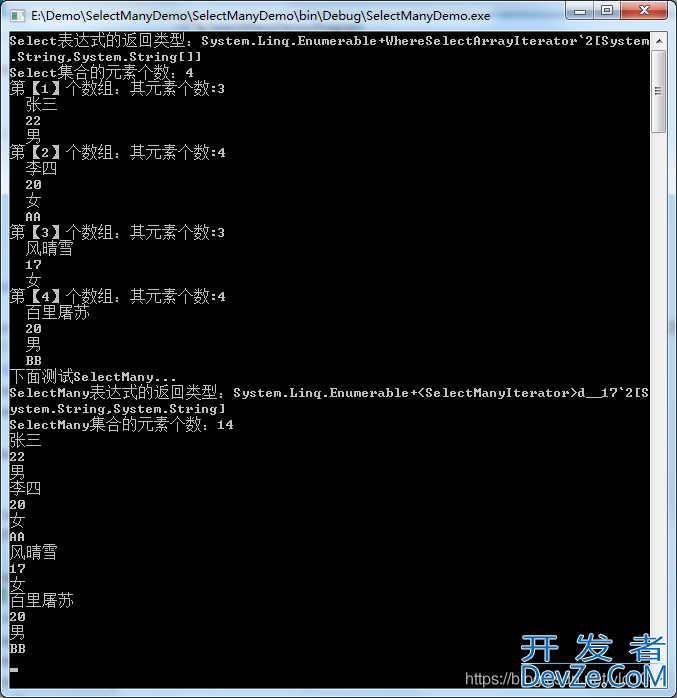目录
- LINQ的Select与SelectMany函数使用
- Select扩展函数
- SelectMany扩展函数
- SelectMany和Select的区别
LINQ的Select与SelectMany函数使用
Select扩展函数
将序列中的每个元素投影到新表单。
返回结果:
- System.Collections.Generic.IEnumerable`1 其元素是调用转换函数的每个元素的结果 source。
Select只是每个元素独立投影到新表单,每个元素独自处理。
SelectMany扩展函数
一个序列的每个元素投影 System.Collections.Generic.IEnumerable`1 并将合并为一个序列将结果序列。
返回结果:
- System.Cojavascriptllections.Generic.IEnumerable`1 其元素是一种一对多转换函数对输入序列中的每个元素调用的结果。
SelectMany投影后合并元素。相当于将多个集合的每一个元素全部拼接,组成一个大的集合。
测试程序如下:
using System;
using System.Collections.Generic;
using System.Linq;
using System.Text;
using System.Threading.Tasks;
namespace SelectManyDemo
{
class Program
{
static void Main(string[] args)
{
string[] collection = new string[] { "张三,22,男", "李四,20,女,AA", "风晴雪,17,女", "百里屠苏,20,男,BB" };
//Select只是每个元素独立投影到新表单,
IEnumerable<string[]> selectCollection = collection.Select(person => person.Split(','));
Console.WriteLine($"Select表达式的返回类型:{selectCollection.GetType()}");
Console.WriteLine($"Select集合的元素个数:{selectCollecjavascripttion.Count()}");
int index = 0;
selectCollection.ToList().ForEach(p =>
{
index++;
Console.WriteLine($"第【{index}】个数组:其元素个数:{ p.Length}");
p.ToList().ForEach(s => Console.WriteLine(" " + s));
});
Console.WriteLine("下面测试SelectMany...");
//投影后合并元素。相当于将多个集合的每一个元素全部拼接,组成一个大的集合
var selectMany = collection.SelectMany(person => person.Split(','));
Console.WriteLine($"SelectMany表达式的返回类型:{selectMany.GetType()}")开发者_C入门;
Console.WriteLine($"SelectMany集合的元素个数:{selectMany.Count()}");
selectMany.ToList().ForEach(p => Console.WriteLine(p));
Console.ReadLine();
}
}
}
程序运行结果截图:

SelectMany和Select的区别
如果我们看这两个扩展函数的定义很容易明白——Select是把要遍历的集合IEnumerable逐一遍历,每次返回一个T,合并之后直接返回一个IEnumerable,而SelectMany则把原有的集合IEnumerable每个元素遍历一遍,每次返回一个IEnumerable,把这些IEnumerable的“T”合并之后整体返回一个IEnumerable。
因此我们可以说一般情况下SelectMany用于返回一个IEnumerable<IEnumerable>的“嵌套”返回情况(把每个IEnumerable合并后返回一个整体的IEnumerable)。因此在嵌套的时候往往可以节省代码,例如输出带有以下的集合:
List<List<int>> numbers = new List<List<int>>()
{
new L编程客栈ist<int>{1,2,3},
new List<int>{4,5,6},
new List<int>{7,8,9}
};
通常情况下要遍历一个嵌套的数组,我们不得不采用二重循环(for或者fopythonreach),不过现在我们可以借助SelectMany进行简化处理(把每个内嵌的List取出,因为每一个List都是IEnumerable,合并成一个大的IEnumerable)。
简编程客栈化如下:
var result = numbers.SelectMany(collection=>collection);
foreach(var item in result)
{
………………
}
以上为个人经验,希望能给大家一个参考,也希望大家多多支持我们。









 加载中,请稍侯......
加载中,请稍侯......
精彩评论